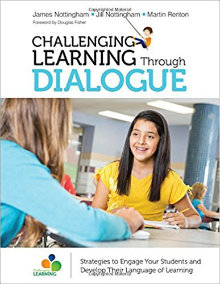Challenging Learning Through Real Dialogue
Challenging Learning Through Dialogue: Strategies to Engage Your Students and Develop Their Language of Learning
By James Nottingham, Jill Nottingham, and Martin Renton
(Corwin, 2017 – Learn more)

“Conversations not only made us sound smarter, I think they actually made us smarter.” ~ middle school student*
The importance of high quality classroom discussion in fostering content learning and critical thinking at the middle level is beyond dispute. But so, unfortunately, is the lack of opportunities many students have to engage in such discussions.
Happily, Challenging Learning through Dialogue: Strategies to Engage Your Students and Develop Their Language of Learning is a powerful resource middle school teachers can use to make their classroom discussions more thoughtful, engaging, and real.

Beyond parroting
Students must critically think about what they are taught, and what better way to help our students do this than through discussion? The authors use the term “dialogue” to emphasis purposeful discussion. This type of discussion does not come about through the “I ask, you respond, I move on” type of recitation. If the students in our classrooms can answer a question we ask “in unison” real discussion is not occurring.
Challenging Learning through Dialogue begins with an examination of the importance of dialogue, and the conditions and steps necessary to initiate successful engaging dialogue in the classroom. For example, in the early chapter “Dialogue to Engage Students” a strategy emphasized to deepen dialogue is “restatement.” During discussion, a teacher restating a student response might briefly summarize that response and ask if his or her understanding is accurate.
This signals to the students not only the importance of listening, but also invites the students making the statement to extend their thinking. During class discussion we want our students to respond not only to our questions, but also to the ideas of other students. When restating what they’ve heard, students learn to project meaning into others’ statements. This might mean one student summarizes a point made by another and then builds on it.
Other ideas for steps to improve dialogue include using follow-up statements, asking for reasons, and reformulating.
A myriad of ideas and strategies
What I found most valuable in this book were the myriad of ideas and strategies that we as middle school teachers can use to initiate high quality discussions in our classrooms.
One of the strategies, for example, is known as Mysteries. Mystery is a strategy where students in small groups use a set of clues to develop a reasoned hypothesis to a central question that is open to more than one answer. It has been one of my favorite strategies for years, and one of my students’ favorites as well.
I personally use three or four students per group, and introduce them to the Mystery procedures as well as the question that they will try to answer. Each group receives an envelope with the clues (I put each clue on a separate strip of paper) prepared for the lesson. The students then explore the clues, categorize them, develop their ideas and inferences, and establish their hypothesis on the question. The discussion takes place as the closure activity.
As an example, in my medieval unit (“I Love the Knightlife”) I use the Mystery strategy as an important component of my lesson on the Black Death. The question that we explore is “how did people of the time understand the Black Death, and how did they try to cope with it.”
As a history teacher, I make a point of using primary source quotes in my clues. For this particular lesson, I have 21 clues. Some of these clues include
When anyone has died no person shall go to the place of the deceased… before or after burial … or attend or go to a meal in that house or place on the said occasion…. – Ordinances of Pistoia
Repent, pray, do penance for your sins – quote from National Center for History in the Schools
Punish yourself by whipping to remove sin – quote from National Center for History in the Schools
“The plague, it is said, began among the unbelievers.” Jean de Vanette
We, the Members of the Physicians of Paris, intend to make known the causes of this pestilence….We, therefore, declare as follows: the stars …exerted [a strange] power [on the] sea…and the waters of the sea arose in the form of a [poisonous cloud]. This [cloud] spread itself through the air in many places on earth…. – A Statement issued in 1348 by the staff of the Paris Medical School
Prior to the conclusion of the chapter on Mystery is a very complete and helpful section entitled “Writing Your Own Mysteries.”
Begin the dialogue engagement process
The majority of Challenging Learning through Dialogue contains strategy after strategy, idea after idea, that teachers can use in their classroom to begin the dialogue engagement process. With each strategy there are sections that clearly explain how you use the strategy in your classroom, complete with examples. Some of the strategies include reasoning cards, large and small group dialogue structures, “Odd One Out,” “Dialogue Detectives,” (similar to Socratic Seminars), and “Make a Choice, Give a Reason.”
We know that high quality discussion/conversation/dialogue is important for improving content learning, critical thinking skills, fostering engagement, and creating confidence. Challenging Learning through Dialogue is an excellent resource for the middle school teacher to use in developing engaging and thoughtful discussion/dialogue opportunities for their students.
_____
*Quote from Jeff Zweirs and Marie Crawford, Academic Conversation: Classroom Talk that Fosters Critical Thinking and Classroom Conversation (Portland, ME: Stenhouse Publishers) 2011. An excellent book on classroom discussion that I would also highly recommend.
_____
Michael M. Yell is a seventh grade social studies teacher in Hudson, Wisconsin. A past middle school social studies teacher of the year, Michael was elected president of the National Council for the Social Studies in 2008-9, and received certification from the National Board for Professional Teaching Standards in 2003 and again in 2013. He can be reached at yellmm@hudson.k12.wi.us.
For a look at another book by the Nottinghams, read this MiddleWeb review: Challenging Learning Through Feedback: How to Get the Type, Tone and Quality of Feedback Right Every Time.




























